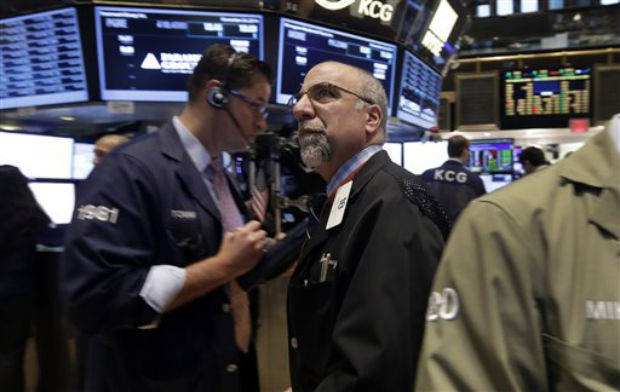
In this Monday, Nov. 24, 2014 photo, trader John Lotito, center, works on the floor of the New York Stock Exchange. A slump in energy prices pushed the stock market back from record levels on Tuesday. AP
NEW YORK—A slump in energy prices pushed the stock market back from record levels on Tuesday.
Energy stocks slid as the price of oil resumed its descent. Traders speculated that member nations of the oil-producing group OPEC would fail to agree on production cuts at an upcoming meeting in Vienna on Thursday. Oil has now dropped almost a third from a peak in June.
While lower oil prices are a long-term boon to consumers and industrial companies, they are a drag on stocks in the near term because energy companies account for about 10 percent of the overall market’s profits.
Despite the losses, the major indexes remain close to all-time highs.
Stocks have been drifting gradually higher this month, having rebounded sharply from a slump in October, as investors have grown more confident that actions from central banks around the world will help bolster the global economy. The gains are likely to continue for now, said Jim McDonald, chief investment strategist at Northern Trust.
“People’s sentiment is still pretty conservative,” McDonald said. “That means that the slow-and-steady market can continue longer than people anticipate.”
The Standard & Poor’s 500 index fell 2.38 points, or less than 0.1 percent, to 2,067.03. The Dow Jones industrial average dropped 2.96 points, or less than 0.1 percent, to 17,814.94. The Nasdaq composite gained 3.36 points, or 0.1 percent, to 4,758.25.
Stocks started the day with small gains after a report showed that the US economy grew at a solid 3.9 percent annual rate in the July-September period, faster than the 3.5 percent that was initially reported. The upward revision was due to higher estimates of spending by consumers and businesses, the Commerce Department said.
That positive report was tempered by news that US consumer confidence fell in November. The Conference Board says its consumer confidence index fell to 88.7, down from a seven-year high of 94.5 in October. The decline primarily reflected less optimism in the short-term outlook as consumers expressed less confidence in current business conditions.
Among individual stocks, Pall, a company that makes filters for the food and health care industries, was the leading gainer in the S&P 500. The company’s stock jumped $3.31, or 3.5 percent, to $98 after its earnings beat the expectations of Wall Street analysts.
Energy stocks slid along with oil prices following reports that the world’s biggest producers are unwilling to cut production to help stop a slump in the price of crude. The sector dropped 1.6 percent and is now down 3.2 percent for the year. It’s the only one of the 10 industry sectors in the S&P 500 that is down for the year.
Representatives from Venezuela, Saudi Arabia, Mexico and Russian state oil giant OAO Rosneft met Tuesday ahead of a meeting of the Organization of the Petroleum Exporting Countries in Vienna and didn’t announce any immediate plans to cut output, The Wall Street Journal reported.
Benchmark US crude fell $1.69 to close at $74.09 a barrel on the New York Mercantile Exchange. Brent crude, a benchmark for international oils used by many US refineries, fell $1.35 to close at $78.33 a barrel on the ICE Futures exchange in London.
In metals trading, the price of gold rose $1.40 to $1,197.10 an ounce. Silver rose 18 cents to $16.55 an ounce and copper fell four cents to $2.96 a pound.
US government bond prices rose. The yield on the 10-year Treasury note fell to 2.26 percent from 2.31 percent Monday. The dollar fell to 117.94 yen from 118.28 yen late Monday. The euro rose to $1.2472.
In other energy futures trading on the NYMEX:
— Wholesale gasoline fell 0.1 cent to close at $2.032 a gallon
— Heating oil fell 0.1 cent to close at $2.395 a gallon.
— Natural gas rose 13.1 cents to close at $4.282 per 1,000 cubic feet– Steve Rothwell